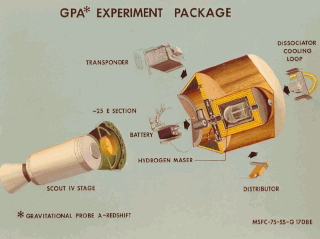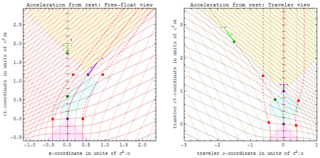Related Research Articles

Faster-than-light travel and communication are the conjectural propagation of matter or information faster than the speed of light. The special theory of relativity implies that only particles with zero rest mass may travel at the speed of light, and that nothing may travel faster.
In classical physics and special relativity, an inertial frame of reference is a frame of reference that is not undergoing any acceleration. It is a frame in which an isolated physical object—an object with zero net force acting on it—is perceived to move with a constant velocity or, equivalently, it is a frame of reference in which Newton's first law of motion holds. All inertial frames are in a state of constant, rectilinear motion with respect to one another; in other words, an accelerometer moving with any of them would detect zero acceleration.

In physics, the special theory of relativity, or special relativity for short, is a scientific theory of the relationship between space and time. In Albert Einstein's original treatment, the theory is based on two postulates:
- The laws of physics are invariant (identical) in all inertial frames of reference.
- The speed of light in vacuum is the same for all observers, regardless of the motion of light source or observer.

In physics, spacetime is a mathematical model that combines the three dimensions of space and one dimension of time into a single four-dimensional manifold. Spacetime diagrams can be used to visualize relativistic effects, such as why different observers perceive differently where and when events occur.

The theory of relativity usually encompasses two interrelated theories by Albert Einstein: special relativity and general relativity, proposed and published in 1905 and 1915, respectively. Special relativity applies to all physical phenomena in the absence of gravity. General relativity explains the law of gravitation and its relation to the forces of nature. It applies to the cosmological and astrophysical realm, including astronomy.

In physics, the twin paradox is a thought experiment in special relativity involving identical twins, one of whom makes a journey into space in a high-speed rocket and returns home to find that the twin who remained on Earth has aged more. This result appears puzzling because each twin sees the other twin as moving, and so, as a consequence of an incorrect and naive application of time dilation and the principle of relativity, each should paradoxically find the other to have aged less. However, this scenario can be resolved within the standard framework of special relativity: the travelling twin's trajectory involves two different inertial frames, one for the outbound journey and one for the inbound journey. Another way of looking at it is to realize the travelling twin is undergoing acceleration, which makes him a non-inertial observer. In both views there is no symmetry between the spacetime paths of the twins. Therefore, the twin paradox is not actually a paradox in the sense of a logical contradiction.

In physics, the principle of relativity is the requirement that the equations describing the laws of physics have the same form in all admissible frames of reference.
In standard cosmology, comoving distance and proper distance are two closely related distance measures used by cosmologists to define distances between objects. Proper distance roughly corresponds to where a distant object would be at a specific moment of cosmological time, which can change over time due to the expansion of the universe. Comoving distance factors out the expansion of the universe, giving a distance that does not change in time due to the expansion of space.

In physics and relativity, time dilation is the difference in the elapsed time as measured by two clocks. It is either due to a relative velocity between them or to a difference in gravitational potential between their locations. When unspecified, "time dilation" usually refers to the effect due to velocity.

In relativity, proper time along a timelike world line is defined as the time as measured by a clock following that line. It is thus independent of coordinates, and is a Lorentz scalar. The proper time interval between two events on a world line is the change in proper time. This interval is the quantity of interest, since proper time itself is fixed only up to an arbitrary additive constant, namely the setting of the clock at some event along the world line.

Gravity Probe A (GP-A) was a space-based experiment to test the equivalence principle, a feature of Einstein's theory of relativity. It was performed jointly by the Smithsonian Astrophysical Observatory and the National Aeronautics and Space Administration. The experiment sent a hydrogen maser—a highly accurate frequency standard—into space to measure with high precision the rate at which time passes in a weaker gravitational field. Masses cause distortions in spacetime, which leads to the effects of length contraction and time dilation, both predicted results of Albert Einstein's theory of general relativity. Because of the bending of spacetime, an observer on Earth should measure a slower rate at which time passes than an observer that is higher in altitude. This effect is known as gravitational time dilation.

Gravitational time dilation is a form of time dilation, an actual difference of elapsed time between two events as measured by observers situated at varying distances from a gravitating mass. The lower the gravitational potential, the slower time passes, speeding up as the gravitational potential increases. Albert Einstein originally predicted this effect in his theory of relativity and it has since been confirmed by tests of general relativity.
In relativistic physics, the coordinates of a hyperbolically accelerated reference frame constitute an important and useful coordinate chart representing part of flat Minkowski spacetime. In special relativity, a uniformly accelerating particle undergoes hyperbolic motion, for which a uniformly accelerating frame of reference in which it is at rest can be chosen as its proper reference frame. The phenomena in this hyperbolically accelerated frame can be compared to effects arising in a homogeneous gravitational field. For general overview of accelerations in flat spacetime, see Acceleration and Proper reference frame.
A non-inertial reference frame is a frame of reference that undergoes acceleration with respect to an inertial frame. An accelerometer at rest in a non-inertial frame will, in general, detect a non-zero acceleration. While the laws of motion are the same in all inertial frames, in non-inertial frames, they vary from frame to frame depending on the acceleration.

In physics, the relativity of simultaneity is the concept that distant simultaneity – whether two spatially separated events occur at the same time – is not absolute, but depends on the observer's reference frame. This possibility was raised by mathematician Henri Poincaré in 1900, and thereafter became a central idea in the special theory of relativity.

In the theory of relativity, it is convenient to express results in terms of a spacetime coordinate system relative to an implied observer. In many coordinate systems, an event is specified by one time coordinate and three spatial coordinates. The time specified by the time coordinate is referred to as coordinate time to distinguish it from proper time.

In relativity theory, proper acceleration is the physical acceleration experienced by an object. It is thus acceleration relative to a free-fall, or inertial, observer who is momentarily at rest relative to the object being measured. Gravitation therefore does not cause proper acceleration, because the same gravity acts equally on the inertial observer. As a consequence, all inertial observers always have a proper acceleration of zero.

A spacetime diagram is a graphical illustration of the properties of space and time in the special theory of relativity. Spacetime diagrams allow a qualitative understanding of the corresponding phenomena like time dilation and length contraction without mathematical equations.

In classical theories of gravitation, the changes in a gravitational field propagate. A change in the distribution of energy and momentum of matter results in subsequent alteration, at a distance, of the gravitational field which it produces. In the relativistic sense, the "speed of gravity" refers to the speed of a gravitational wave, which, as predicted by general relativity and confirmed by observation of the GW170817 neutron star merger, is the same speed as the speed of light (c).

Velocity is the directional speed of an object in motion as an indication of its rate of change in position as observed from a particular frame of reference and as measured by a particular standard of time. Velocity is a fundamental concept in kinematics, the branch of classical mechanics that describes the motion of bodies.
References
- Locality hypothesis and the speed of light, G.Longhi, 2006
- Propagation of light in non-inertial reference frames
- ↑ Relativity and the Nature of Spacetime, Vesselin Petkov, Springer, 2009, ISBN 978-3-642-01952-4, Chapter: 7